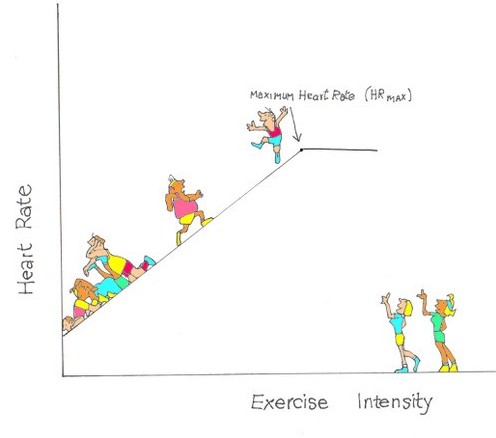MEASURING PHYSICAL FITNESS
I will start with how the professionals do it – in my next blog I will be telling you how to measure your own fitness level for yourself. Let me repeat that the best measure of physical fitness or cardio-respiratory fitness or aerobic capacity is the maximal oxygen uptake or VO2max (see Glossary and previous blog “Exercise and oxygen”). However most methods of measuring physical fitness or aerobic capacity estimate VO2max rather than measure it directly.
Direct measurement of VO2max
It is a time consuming and costly business to measure VO2max. It needs specialised and expensive equipment. It is usually performed on a calibrated bicycle ergometer or on a treadmill. The exerciser performs the exercise while breathing through a tube connected to an oxygen analyser which measures the rate at which oxygen is being extracted from the inhaled air. The individual is subjected to a steadily increasing workload until he or she can continue no longer. Real time display of oxygen uptake shows a linear increase in oxygen uptake with increasing workload until the maximal oxygen uptake is reached. At this point the graph levels off at what is known as the anaerobic threshold. The exerciser is capable of a bit more effort but very soon has to stop from exhaustion. Increasing oxygen uptake is facilitated by increasing heart rate which follows a similar trajectory, increasing to its maximum at peak exercise. The graph which heads this Blog illustrates this point.
Maximum oxygen uptake is usually between 1.5 and 3.5 litres per minute. This is converted into millilitres per minute per kilogram of body weight by multiplying by 1,000 and dividing by the weight of the individual. It can be further converted into Metabolic Equivalents (METs) by dividing by 3.5, since a MET is 3.5ml/min/kg (see Glossary and previous blog “Exercise and oxygen”) So for a 70kg person with an oxygen uptake at maximum effort of 2 litres per minute:
VO2max = 2,000ml per minute and:
2,000 divided by 70 gives the oxygen consumption in ml per minute per kg body weight = 28.6ml/min/kg
METmax = 28.6 divided by 3.5 = 8.16 METs.
Estimated Measurement of VO2max
Most measurements of fitness, however, estimate oxygen uptake and rely on the known oxygen cost of the exercise being undertaken.
The motorized treadmill is the most popular method for use in the laboratory. A variety of different protocols can be used, the most popular being the famous Bruce protocol, devised by the Seattle based cardiologist, Robert Bruce. The treadmill is started at 1.7mph and a 10 degree slope and is increased every three minutes through seven stages to the maximum of 6.0mph and a 22 degree slope. The time spent on the treadmill before exhaustion is used to predict VO2max. The protocol was devised to make this easy. Each minute on the treadmill uses about 3.5ml/min/kg (1 MET). This applies to everyone, regardless of weight because the test measures the effort of the individual moving him or herself.
Bicycle ergometers are much more portable than treadmills and are the most popular instruments for use in “field” studies. Estimation of exercise intensity requires the work done on the bicycle to be measured. Workload is controlled by the resistance to pedaling and speed of pedaling. With mechanically braked bicycles the resistance depends upon a weight applied to the braking system and if workload is to be calculated the peddler must bicycle at a constant speed, using a metronome. For electronically braked machines the workload is set at the required level and resistance then varies with pedal speed so constant pedaling rate is not required. Workload is measured in watts (joules per second).
Again a variety of protocols may be used. One such starts the individual at 25 or 50 or 75 watts and increases the workload by 25 watts every three to five minutes – long enough to reach “steady state” exercise. The cyclist continues to exhaustion and the oxygen uptake at this point is calculated from a knowledge of the oxygen cost of cycling. In this case the cost is expressed as mililitres of oxygen per minute – which must be divided by the weight of the individual to give the VO2 in ml/min/kg.
Next time I will tell you how to measure your fitness level and what that measurement means.
PS
I was very pleased to read a really sensible letter1 in the BMJ which referred to a January article about exercise and the prevention of chronic diseases. These are the non communicable diseases like diabetes, heart disease and osteoporosis which are much more common in inactive older people than active ones. They lead to frailty in old age which is such a blight on the lives of the elderly and which cost them and society so dearly.
The letter writer says “In the UK, in the past five years, £900m (€1bn; $1.2bn) has been cut from public health grants given to local councils. These grants support exactly what this paper prescribes as the antidote to chronic disease morbidity.” and “This article demands a policy reset with increased funding for public health. A greater emphasis needs to be placed on programmes that facilitate people making positive lifestyle choices. Capacity building, agency, and self-efficacy need to be tools for reducing pressure on already overburdened healthcare services.”
Well said indeed.
- BMJ 2020;368:m427
Subscribe to the blog
Categories
- Accelerometer
- Alzheimer's disease
- Blood pressure
- BMI
- Cancer
- Complications
- Coronary disease
- Cycling
- Dementia
- Diabetes
- Events
- Evidence
- Exercise promotion
- Frailty
- Healthspan
- Hearty News
- Hypertension
- Ill effects
- Infections
- Lifespan
- Lipids
- Lung disease
- Mental health
- Mental health
- Muscles
- Obesity
- Osteoporosis
- Oxygen uptake
- Parkinson's Disease
- Physical activity
- Physical fitness
- Pregnancy
- Running
- Sedentary behaviour
- Strength training
- Stroke
- Uncategorized
- Walking


